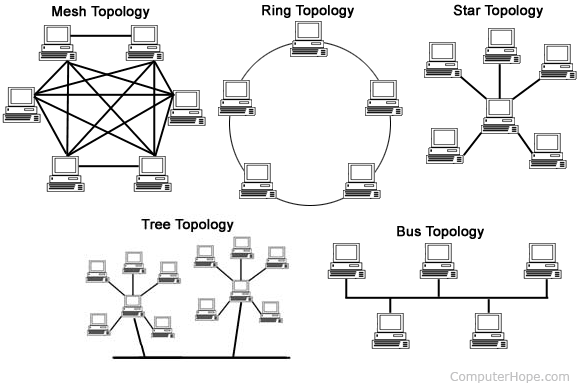Episode 16 - Networking Basics
Posted on Fri 08 March 2019 in Engineering • 3 min read
A network is defined as “A network is a collection of computers, servers, mainframes, network devices, peripherals, or other devices connected to one another to allow the sharing of data”. There are various configurations of networks for specific design scenarios as represented in:

Typical residential home networks are configured in a tree topology that is connected to the internet. This typically consists of a single router/modem that serves all the end-user devices on the network with internet connection. The router also acts as a gateway for the devices connected on the network to communicate with one another.
Packets of data that are generated by the devices are encapsulated with destination routing information; which is passed to the router at the center which directs the data to it’s destination in the network. For example, a user connects to the router to gain access to a wider network that is the internet to load this webpage.
If there was a higher risk on losing the communications medium between two devices (cable failure), then bus would be at disadvantage here but ring might prove more beneficial although transmission would be slower as the network connection would be further away (go around the ring in the case of the picture above).
Mesh Topology
By explaining network topologies by comparing to a basic Wi-Fi network normally gets the message across. A mesh network can prove beneficial to areas in which a star network isn't covering the area you wish it to, for example, if you have 'dark' spots where you don't receive Wi-Fi signal, a mesh network might be better suited. A practical implementation of a mesh network can be seen in shopping centre's Wi-Fi networks where multiple routers are placed strategically such that you can walk around the entire property and not lose signal.
Ring Topology
While star is a very popular configuration of network, it however is not the most ideal configuration for some types of networks. For example, if you had a series of devices that all needed to talk to each other, even if one was to fail, then a ring/bus/mesh would be more applicable where there is always a path to everyone else if a device was to fall offline.
Star Topology
If you consider a home Wi-Fi network that doesn't connect out further (no internet connection) then you have a basic star network. The center of the star in this scenario would be the Wi-Fi router, you can still connect to the other devices but not outside of your network and all messages have to travel through the router.
Tree Topology
A tree topology is just creating multiple star networks off the back of another network. For example, if you considered the network that is your internet connection from the street (or satellite), then connecting to your modem (gateway) then furthering to your devices in your home, you have a basic tree network.
Bus Topology
Where devices are connected to a single medium (cable) to communicate with each other, you now have a bus network. A bus network proves it's advantages by less cabling than star networks, ease of installation of linear networks and works well with small networks. It is easy enough to add new devices to the network and if one fails (but the medium doesn't) then all devices can still communicate. Disadvantages arise when problems occur as it difficult to determine the cause of an issue on a bus network.